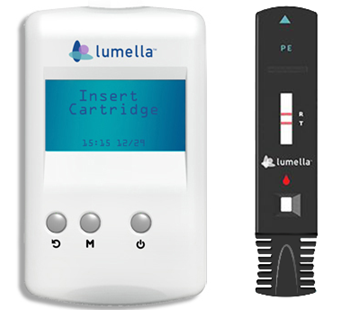Key benefits
- Contributes to diagnosing preeclampsia in only 10 minutes
- Point-of-care test
- Use of finger stick whole blood (or serum)
- No additional equipment needed, no investment needed
Features
- High sensitivity (99%) and specificity (93%)
- Registered as Medical Device for In Vitro Diagnostic Use (IVD/CE)
- Measures concentration GlyFn between 50-800 µg/mL
Applications
- Assessment of preeclampsia
- Rule in or rule out preeclampsia in 10 minutes
Introduction
Preeclampsia affects around 4% of pregnancies worldwide and is characterized by hypertension and proteinuria. It usually occurs after 20 weeks of pregnancy. The wide variation of the clinical presentation makes prediction, diagnosis and assessment of the disease difficult. Undetected, preeclampsia can progress into eclampsia, which is associated with substantial perinatal morbidity and mortality in mothers and infants. Preeclampsia and eclampsia account for 10 to 15% of maternal deaths worldwide.
Glycosylated fibronectin and preeclampsia biomarkers
Studies have shown that an elevated level of glycosylated fibronectin (GlyFn) is associated with preeclampsia1-3. The concentration of GlyFn in maternal blood is increases before the onset of the disease, which makes GlyFn as a biomarker a valuable tool for the predication and diagnosis of preeclampsia. Other biomarkers associated with preeclampsia, such as placental growth factor (PlGF) and soluble fms-like tyrosine kinase-1 (sFlt-1), may vary in concentration during healthy pregnancies. GlyFn levels remain constant in healthy pregnancies, which makes GlyFn a reliable biomarker in the diagnosis of preeclampia2.
Literature
Diagnosis of preeclampsia
Two studies have been published in which GlyFn is used to diagnose preeclampsia1-2.
In the first study, the sensitivity of GlyFn to diagnose preeclampsia was found to be 97%, while the specificity was 93% (Table 1). The authors of the study conclude that GlyFn is a robust biomarker for monitoring preeclampsia1.
Table 1. Sensitivity and specificity of GlyFn for the diagnosis of preeclampsia1.
| Study | Rasanen1 (diagnosis) |
| Biomarker | GlyFn |
| Sensitivity | 97% |
| Specificity | 93% |
In the second study, the sensitivity of the Lumella® Preeclampsia Test to diagnose preeclampsia was found to be 99%, while the specificity was 93% (Table 2). In comparison with the sensitivity and specificity of Pappalysin-2 (PAPPA2), PlGF and sFlt-1, GlyFn showed the best overall performance (Table 2).
Table 2. Sensitivity and specificity of GlyFn for the diagnosis of preeclampsia2.
| Study | Nagalla2 (diagnosis) | |||
| Biomarker | GlyFn | PAPPA2 | PlGF | sFlt-1 |
| Sensitivity | 99% | 75% | 92% | 97% |
| Specificity | 93% | 96% | 92% | 44% |
Prediction of preeclampsia
In a study done by Huhn the performance of the biomarkers for short-term prediction of preeclampsia (within 4 weeks) was investigated3. GlyFn exhibited the best performance of the biomarkers tested, with a sensitivity of 91%, and a specificity of 86% (Table 3). This study concluded that the Lumella® Preeclampsia Test is advantageous to enable accurate, rapid and inexpensive prediction of preeclampsia3.
Table 3. Sensitivity and specificity of preeclampsia biomarkers calculated in a clinical study for the prediction of preeclampsia within 4 weeks3.
| Study | Huhn3 (4 weeks prediction) | |||
| Biomarker | GlyFn | PAPPA2 | PlGF | sFlt-1 |
| Sensitivity | 91% | 87% | 81% | 84% |
| Specificity | 86% | 77% | 83% | 91% |
Lumella® Preeclampsia Test
The Lumella® Preeclampsia Test measures the concentration GlyFn in whole blood. Only 5 µL of whole blood is needed for the test, therefore a finger stick is sufficient. In addition, serum can also be used for the Lumella® Preeclampsia Test (do not use anticoagulated blood, as heparin and EDTA interfere with the test). The blood sample is diluted in a buffer, applied to the cartridge and inserted into the reader. Results can be interpreted within 10 minutes. This procedure is based on the lateral flow sandwich immunoassay method. The Lumella® Preeclampsia Test System comprises the Lumella® reader and a calibration cartridge (RFID card), and therefore no expensive additional equipment is needed.
The Lumella® Preeclampsia Test is intended to be used as an aid in the assessment of preeclampsia in conjunction with other clinical and laboratory information.
| Item | Content of the Kit | Product code |
| Lumella® Preeclampsia Test System* | 10 test cartridges, 1 reader, 1 RFID card | 2002 |
| Lumella® Preeclampsia Test Cartridges* | 20 Test cartridges, 1 RFID card | 2001 |
* This product is distributed for Diabetomics.Inc, USA.
* Only for distribution in the Netherlands, Belgium and Luxembourg.
- Nagalla, S.R., et al., Glycosylated fibronectin point-of-care test for diagnosis of pre-eclampsia in a low-resource setting: a prospective Southeast Asian population study. BJOG, 2020. 127(13): p. 1687-1694.
- Rasanen, J., et al., Maternal serum glycosylated fibronectin as a point-of-care biomarker for assessment of preeclampsia. Am J Obstet Gynecol, 2015. 212(1): p. 82 e1-9.
- Huhn, E.A., et al., Maternal serum glycosylated fibronectin as a short-term predictor of preeclampsia: a prospective cohort study. BMC Pregnancy Childbirth, 2020. 20(1): p. 128.
